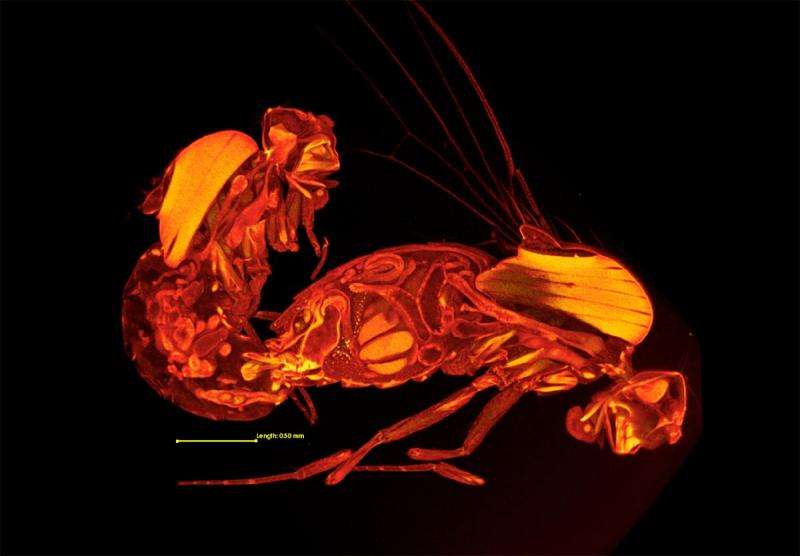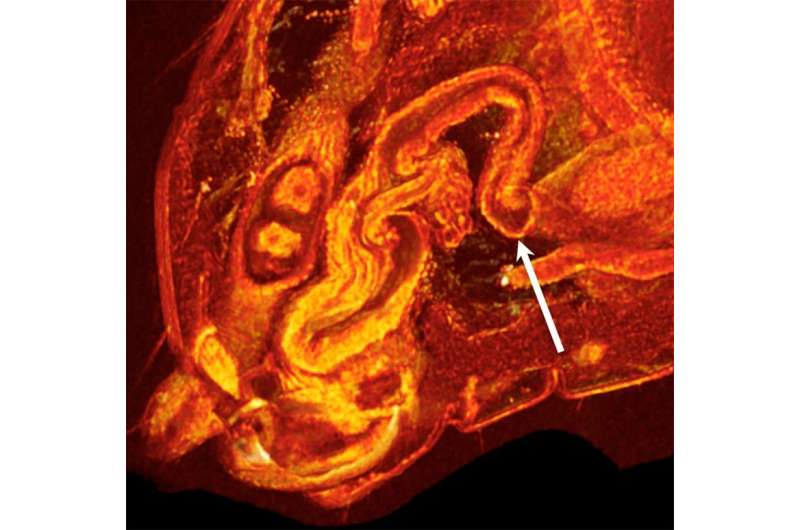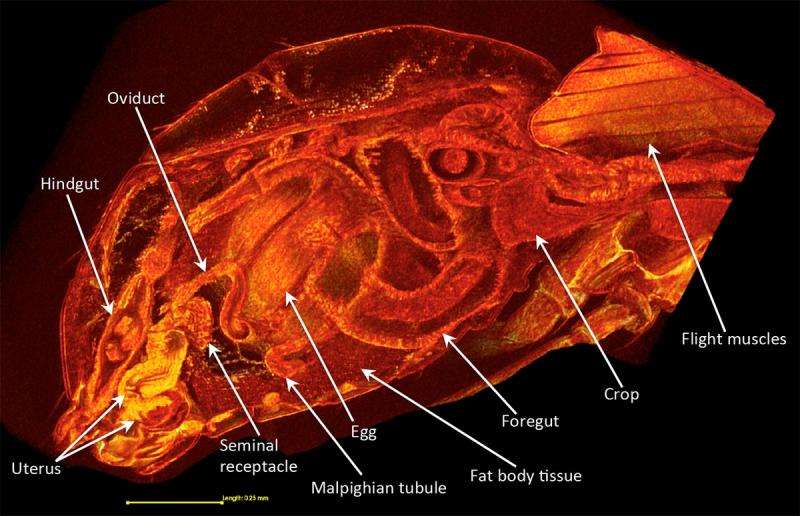3-D scans of mating fruit flies uncovers female biology

Following in the footsteps of Leonardo Da Vinci's 1493 anatomical sketch of a man and woman, "The Copulation," Cornell researchers used cutting-edge X-ray technology to noninvasively image fruit flies during and after mating.
A study, published online ahead of print June 3 in the Proceedings of the National Academy of Sciences, describes how researchers used the Cornell Biotechnology Resource Center's high resolution micro-CT (computed tomography) scanner to acquire detailed 3-D datasets of morphological changes that occur in female fruit flies' (Drosophila melanogaster) reproductive tracts during and after mating.
The analysis revealed how ovulation, egg movement, sperm storage, sperm release and fertilization are coordinated. The findings are important for understanding basic reproductive biology with implications for insect control. But the study also gives an inside view of how male molecules from seminal fluids affect female physiology and facilitate reproductive processes – mechanisms that have parallels in other insects, mammals and humans.
"This is the first time that anyone has actually been able to get a view of exactly what is going on inside the female fruit fly, in response to mating, and during her reproduction," said Mariana Wolfner, the Goldwin Smith Professor of Molecular Biology and Genetics in the College of Arts and Sciences and the paper's senior author. Alexandra Mattei '14, now a graduate student in Molecular and Cellular Biology at Harvard University and the paper's lead author, conducted the research as part of her undergraduate honors thesis in biology.

One challenge of the study was preparing flies for CT scanning during various mating stages and post-mating. An x-ray CT instrument imaged objects with a resolution as fine as 1/50th of the width of a human hair, providing 3-D datasets of images that researchers can use to virtually dissect the specimen.
Mattei took mating flies and flash froze them with liquid nitrogen at different times in the process. She then lassoed flies around their necks with strands of her own hair to immerse the otherwise-buoyant flies in a fixative.
Co-author Mark Riccio, a research engineer and micro-CT facility director, created a system for scanning the flies. CT scans showed how the uterus tilts away to stretch out and straighten looped oviducts post-mating, as triggered by proteins in the male's seminal fluid. "We think the straightening of this loop makes it possible for the egg to leave the ovary and enter the oviduct," said Wolfner.
In insects, eggs move one at a time from the ovaries, through the oviducts and into the uterus, where a sperm fertilizes the egg. The researchers observed how the uterus' shape changes: tightly closed before mating, it opens up and balloons during mating so an egg can fit in. The uterus then clamps down on the egg, which the researchers hypothesize holds the egg in place for fertilization.

The scans also clearly showed how the male punctures the female's reproductive tract during mating, and how the male clasps onto the female to get in position for mating, interconnecting in a Velcro-like manner with female bristles.
By using mutant female flies without eggs and male mutants that lacked key seminal proteins, the researchers also proved that a particular male seminal protein was needed for the oviducts to unloop, allowing the female to ovulate.
"These results are important because they define how specific chemical or cellular signals regulate morphology – and thus functions – along the reproductive tract," said Wolfner. "This understanding should be generalizable to all animals."
More information: "Integrated 3D view of postmating responses by the Drosophila melanogaster female reproductive tract, obtained by micro-computed tomography scanning." PNAS 2015 ; published ahead of print June 3, 2015, DOI: 10.1073/pnas.1505797112
Journal information: Proceedings of the National Academy of Sciences
Provided by Cornell University



















